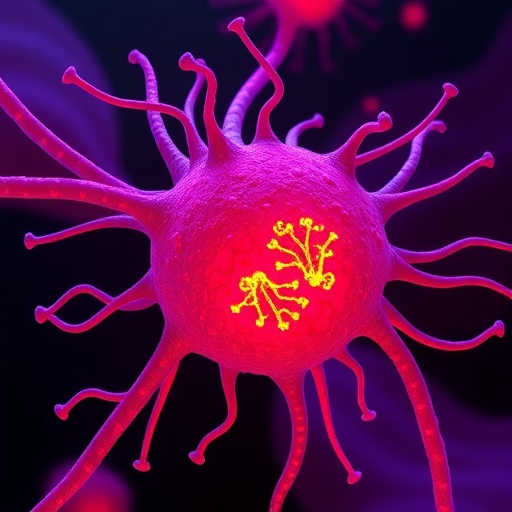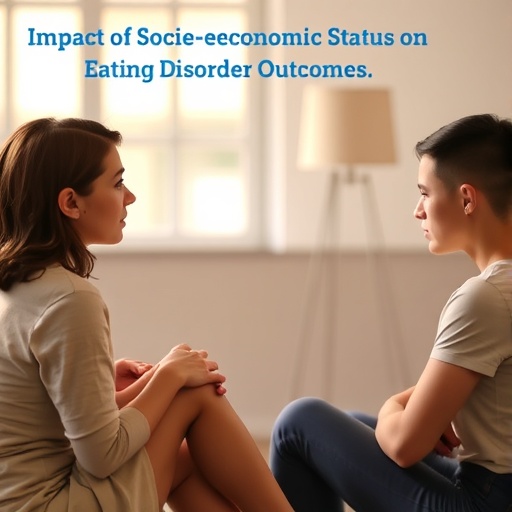In the evolving landscape of cancer biology, the tumor suppressor protein p53 stands as a pivotal guardian of cellular integrity, orchestrating responses to DNA damage and preventing oncogenic transformation. However, mutations within the TP53 gene—a hallmark in a vast majority of human cancers—transform this protective sentinel into a driver of malignancy. A groundbreaking study published in Cell Death Discovery by Dolma et al. (2025) unveils a previously uncharted mechanism by which mutant p53 proteins facilitate a novel cellular phenomenon: the induction of SH3BGRL expression that promotes cell engulfment, potentially redefining our understanding of tumor progression and intercellular dynamics.
The study centers on mutant p53’s ability to modulate the expression of SH3BGRL, a gene encoding a protein within the SH3 domain-binding glutamic acid-rich-like family. Although SH3BGRL has been implicated in various cellular processes including cytoskeletal regulation and cell motility, its direct connection to mutant p53 had not been elucidated before. This discovery opens avenues into how mutant p53 may manipulate cellular environments, enabling aggressive behaviors characteristic of malignant cells.
Cell engulfment, a process distinct from canonical phagocytosis typically observed in immune cells, involves the uptake of one cell by another and has been increasingly recognized as a mechanism contributing to tumor heterogeneity and microenvironmental remodeling. Dolma and colleagues provide compelling evidence that aberrant SH3BGRL expression, instigated by mutant p53, promotes the engulfment of neighboring cells, thereby contributing to tumor cell survival and adaptability. This activity not only supports tumor expansion but also underscores a potential mechanism by which cancer cells evade immune surveillance and therapeutic interventions.
.adsslot_VPeuR4pCmM{ width:728px !important; height:90px !important; }
@media (max-width:1199px) { .adsslot_VPeuR4pCmM{ width:468px !important; height:60px !important; } }
@media (max-width:767px) { .adsslot_VPeuR4pCmM{ width:320px !important; height:50px !important; } }
ADVERTISEMENT
At a molecular level, the study reveals that mutant p53 interacts with transcriptional networks to upregulate SH3BGRL expression. By employing chromatin immunoprecipitation assays and reporter analyses, the researchers demonstrate that mutant forms of p53 bind to specific enhancer regions within the SH3BGRL promoter, facilitating its transcriptional activation. This contrasts starkly with the wild-type p53’s role in transcriptional repression of oncogenic pathways, highlighting the multifaceted and context-dependent nature of p53 mutations.
Notably, the functional consequences of SH3BGRL upregulation extend to profound cytoskeletal alterations. The protein’s SH3 domain-binding motifs engage with actin-regulatory components, promoting the cytoskeletal rearrangements necessary for membrane ruffling and the engulfment phenomenon. Time-lapse imaging coupled with molecular perturbation experiments confirmed that elevated SH3BGRL levels enhance the internalization of adjacent cells or cellular debris, a process that seems to contribute to cellular fitness under stress conditions.
The authors also observed that this cell engulfment orchestrated by mutant p53 and SH3BGRL is associated with metabolic rewiring. Engulfed cells provide nutrients and signaling molecules that bolster the survival and proliferation of the host tumor cells, particularly within hypoxic or nutrient-deprived microenvironments. This metabolic crosstalk augments tumor resilience, potentially explaining resistance mechanisms underlying chemotherapy or radiation treatment failure.
Moreover, the study delves into the interplay between mutant p53-induced SH3BGRL expression and immune evasion. Engulfment of immune cells, such as tumor-infiltrating lymphocytes or macrophages, could impair anti-tumor immune responses, thereby fostering an immunosuppressive niche favorable to tumor expansion. This dimension highlights the broader implications of mutant p53-driven processes, not only in autonomous tumor cell behavior but also in sculpting the tumor microenvironment.
Importantly, the research employs both in vitro cell culture models and in vivo murine tumor xenografts to validate the relevance of SH3BGRL-mediated engulfment in cancer progression. Knockdown experiments targeting SH3BGRL in mutant p53-expressing cancer cells revealed a marked reduction in engulfment capacity and tumor growth rates, suggesting a novel therapeutic vulnerability. These findings pave the way for future interventions aimed at disrupting mutant p53’s downstream effectors to counteract tumor aggressiveness.
From a broader perspective, this study situates SH3BGRL within an expanding network of mutant p53 gain-of-function targets that subvert normal cellular functions to support malignancy. It underscores the complexity of targeting mutant p53-driven oncogenesis, where the mutant protein not only loses tumor suppressive actions but also actively co-opts gene expression programs to enhance malignancy through noncanonical mechanisms such as cell engulfment.
The identification of SH3BGRL as a critical mediator of mutant p53’s pathological activity also prompts investigation into its role across diverse cancer types harboring TP53 mutations. Given the prevalence of p53 mutations in human cancers, the mechanisms described could represent a widespread tumor-promoting axis, with SH3BGRL expression correlating to clinical outcomes and aggressiveness, thus representing a candidate biomarker for prognosis and treatment response.
In discussing potential therapeutic applications, the study highlights opportunities to develop small molecules or RNA-based therapies that disrupt SH3BGRL expression or function. Considering the protein’s involvement in cytoskeletal dynamics integral to cell engulfment, targeting SH3BGRL could impair a tumor’s ability to remodel its microenvironment and sustain nutrient acquisition, sensitizing it to conventional therapies or immune-mediated clearance.
Furthermore, this research reinvigorates the exploration of cancer cell cannibalism or entosis as contributing factors in tumor biology. By linking mutant p53 to SH3BGRL-mediated engulfment, Dolma et al. not only illuminate a unique facet of tumor plasticity but also challenge prevailing paradigms that focus predominantly on proliferation and metastasis, advocating for a more comprehensive understanding of intercellular interactions within tumors.
The mechanistic insights provided also suggest novel diagnostic strategies. Imaging modalities or biopsy analyses assessing SH3BGRL expression levels and engulfment activity could enhance early detection of aggressive tumor phenotypes, offering clinicians new tools to tailor treatment strategies based on the molecular characteristics driven by mutant p53.
Finally, the study’s integration of advanced genomic, proteomic, and live-cell imaging technologies exemplifies the multidisciplinary approach needed to unravel the intricacies of mutant p53 biology. By bridging molecular pathways with cellular behavior and tumor physiology, this research advances the frontier of cancer biology, setting the stage for transformative therapeutic innovations.
In conclusion, Dolma and colleagues have unveiled a compelling new narrative in cancer progression whereby mutant p53-induced SH3BGRL expression propels cell engulfment, endowing tumor cells with enhanced survival and adaptive capacities. This discovery not only deepens our understanding of mutant p53’s oncogenic repertoire but also identifies SH3BGRL as a prospective target for innovative cancer therapies aimed at dismantling tumor plasticity and resistance mechanisms. As the battle against cancer presses forward, unraveling such complex molecular interdependencies remains paramount in the quest for more effective and durable treatments.
Subject of Research: Mutant p53-mediated induction of SH3BGRL expression and its role in promoting cell engulfment in cancer cells.
Article Title: Mutant p53 induces SH3BGRL expression to promote cell engulfment.
Article References:
Dolma, L., Patterson, M.I., Banyard, A. et al. Mutant p53 induces SH3BGRL expression to promote cell engulfment. Cell Death Discov. 11, 288 (2025). https://doi.org/10.1038/s41420-025-02582-x
Image Credits: AI Generated
DOI: https://doi.org/10.1038/s41420-025-02582-x
Tags: cell motility and cytoskeletal regulationcellular environments and aggressive tumor behaviorcellular processes influenced by mutant p53DNA damage response and oncogenic transformationgroundbreaking discoveries in cancer mechanismsimplications of mutant p53 in malignancyintercellular dynamics in tumor progressionmechanisms of tumor heterogeneitymutant p53 and cancer biologynovel pathways in cancer researchSH3BGRL gene function in cell engulfmenttumor suppressor protein roles





